An Innovative Trombe Wall for Winter Use: The Thermo-Diode Trombe Wall
Abstract
1. Introduction
2. Materials and Methods
2.1. Experimental Set-Up
2.2. Winter Operating Principles
Rha ≥ Rls
- Rg is the thermal resistance of the glazing system;
- Ragl/agu is the thermal resistance of the lower/upper section of the air gap;
- Rild/Rilu is the thermal resistance of the lower/upper section of the insulation layer;
- Rwll/Rwlu is the thermal resistance of the lower/upper section of the wall layer;
- Rsi and Rse are the surface air-wall thermal resistances.
2.3. Summer Operating Principles
- pd is the chimney buoyancy force (Pa);
- hch is the chimney height (m);
- g is the gravitational acceleration (m/s2);
- ρae is the external air density (kg/m3);
- ρach is the air density inside the chimney (kg/m3).
2.4. Thermal Storage Tests
3. Results and Discussion
3.1. Thermal Storage Capacity of the PCM Containers
3.2. Analysis in Clear-Sky Conditions
3.3. Analysis in Overcast Sky Conditions
3.4. Trombe Wall Efficiency
- is the solar irradiation available on the TWTD absorption surface (W/m2);
- is the heat flux entering the conditioned space through the internal wall (W/m2);
- r is the ratio between the distribution area Ad that provides heat flux to the indoor spaces to the external glazing area Ag that receives the solar radiation. The integrals are performed over the entire day considered.
4. Conclusions
5. Patents
Author Contributions
Funding
Conflicts of Interest
References
- Telichenko, V.; Benuzh, A.; Eames, G.; Orenburova, E.; Shushunova, N. Development of Green Standards for Construction in Russia. Procedia Eng. 2016, 153, 726–730. [Google Scholar] [CrossRef]
- Bevilacqua, P.; Bruno, R.; Arcuri, N. Green roofs in a Mediterranean climate: Energy performances based on in-situ experimental data. Renew. Energy 2020, 152, 1414–1430. [Google Scholar] [CrossRef]
- Imessad, K.; Messaoudene, N.A.; Belhamel, M. Performances of the Barra-Costantini passive heating system under Algerian climate conditions. Renew. Energy 2004, 29, 357–367. [Google Scholar] [CrossRef]
- Nicoletti, F.; Carpino, C.; Cucumo, M.A.; Arcuri, N. The Control of Venetian Blinds: A Solution for Visual Comfort. Energies 2020, 13, 1731. [Google Scholar] [CrossRef]
- Cascone, S.M.; Cascone, S.; Vitale, M. Building insulating materials from agricultural by-products: A review. In Sustainability in Energy and Buildings; Springer: Berlin/Heidelberg, Germany, 2020. [Google Scholar]
- Hami, K.; Draoui, B.; Hami, O. The thermal performances of a solar wall. Energy 2012, 39, 11–16. [Google Scholar] [CrossRef]
- Koyunbaba, B.K.; Yilmaz, Z. The comparison of Trombe wall systems with single glass, double glass and PV panels. Renew. Energy 2012, 45, 111–118. [Google Scholar] [CrossRef]
- Krüger, E.; Suzuki, E.; Matoski, A. Evaluation of a Trombe wall system in a subtropical location. Energy Build. 2013, 66, 364–372. [Google Scholar] [CrossRef]
- Dabaieh, M.; Elbably, A. Ventilated Trombe wall as a passive solar heating and cooling retrofitting approach; a low-tech design for off-grid settlements in semi-arid climates. Sol. Energy 2015, 122, 820–833. [Google Scholar] [CrossRef]
- Soussi, M.; Balghouthi, M.; Guizani, A. Energy performance analysis of a solar-cooled building in Tunisia: Passive strategies impact and improvement techniques. Energy Build. 2013, 67, 374–386. [Google Scholar] [CrossRef]
- Błotny, J.; Nemś, M. Analysis of the Impact of the Construction of a Trombe Wall on the Thermal Comfort in a Building Located in Wrocław, Poland. Atmosphere 2019, 10, 761. [Google Scholar] [CrossRef]
- Abbassi, F.; Dimassi, N.; Dehmani, L. Energetic study of a Trombe wall system under different Tunisian building configurations. Energy Build. 2014, 80, 302–308. [Google Scholar] [CrossRef]
- Jaber, S.; Ajib, S. Optimum design of Trombe wall system in mediterranean region. Sol. Energy 2011, 85, 1891–1898. [Google Scholar] [CrossRef]
- Agurto, L.; Allacker, K.; Fissore, A.; Agurto, C.; De Troyer, F. Design and experimental study of a low-cost prefab Trombe wall to improve indoor temperatures in social housing in the Biobío region in Chile. Sol. Energy 2020, 198, 704–721. [Google Scholar] [CrossRef]
- Bajc, T.; Todorović, M.N.; Svorcan, J. CFD analyses for passive house with Trombe wall and impact to energy demand. Energy Build. 2015, 98, 39–44. [Google Scholar] [CrossRef]
- Abdeen, A.; Serageldin, A.A.; Ibrahim, M.G.E.; El-Zafarany, A.; Ookawara, S.; Murata, R. Experimental, analytical, and numerical investigation into the feasibility of integrating a passive Trombe wall into a single room. Appl. Therm. Eng. 2019, 154, 751–768. [Google Scholar] [CrossRef]
- Shashikant, K.N. Numerical analysis of house with trombe wall. Int. Res. J. Eng. Technol. 2016, 3, 966. [Google Scholar]
- Hong, X.; He, W.; Hu, Z.; Wang, C.; Ji, J. Three-dimensional simulation on the thermal performance of a novel Trombe wall with venetian blind structure. Energy Build. 2015, 89, 32–38. [Google Scholar] [CrossRef]
- Zhou, L.; Huo, J.; Zhou, T.; Jin, S. Investigation on the thermal performance of a composite Trombe wall under steady state condition. Energy Build. 2020, 214, 109815. [Google Scholar] [CrossRef]
- Hong, X.; Leung, M.K.H.; He, W. Effective use of venetian blind in Trombe wall for solar space conditioning control. Appl. Energy 2019, 250, 452–460. [Google Scholar] [CrossRef]
- Stazi, F.; Mastrucci, A.; di Perna, C. Trombe wall management in summer conditions: An experimental study. Sol. Energy 2012, 86, 2839–2851. [Google Scholar] [CrossRef]
- Bevilacqua, P.; Benevento, F.; Bruno, R.; Arcuri, N. Are Trombe walls suitable passive systems for the reduction of the yearly building energy requirements? Energy 2019, 185, 554–566. [Google Scholar] [CrossRef]
- Hu, Z.; He, W.; Hong, X.; Ji, J.; Shen, Z. Numerical analysis on the cooling performance of a ventilated Trombe wall combined with venetian blinds in an office building. Energy Build. 2016, 126, 14–27. [Google Scholar] [CrossRef]
- Bellos, E.; Tzivanidis, C.; Zisopoulou, E.; Mitsopoulos, G.; Antonopoulos, K.A. An innovative Trombe wall as a passive heating system for a building in Athens—A comparison with the conventional Trombe wall and the insulated wall. Energy Build. 2016, 133, 754–769. [Google Scholar] [CrossRef]
- Abbassi, F.; Dehmani, L. Experimental and numerical study on thermal performance of an unvented Trombe wall associated with internal thermal fins. Energy Build. 2015, 105, 119–128. [Google Scholar] [CrossRef]
- Rabani, M.; Rabani, M. Heating performance enhancement of a new design trombe wall using rectangular thermal fin arrays: An experimental approach. J. Energy Storage 2019, 24, 100796. [Google Scholar] [CrossRef]
- Rabani, M.; Kalantar, V.; Dehghan, A.A.; Faghih, A.K. Empirical investigation of the cooling performance of a new designed Trombe wall in combination with solar chimney and water spraying system. Energy Build. 2015, 102, 45–57. [Google Scholar] [CrossRef]
- Hu, Z.; Zhang, S.; Hou, J.; He, W.; Liu, X.; Yu, C.; Zhu, J. An experimental and numerical analysis of a novel water blind-Trombe wall system. Energy Convers. Manag. 2020, 205, 112380. [Google Scholar] [CrossRef]
- Szyszka, J. Experimental evaluation of the heat balance of an interactive glass wall in a heating season. Energies 2020, 13, 632. [Google Scholar] [CrossRef]
- Szyszka, J. Simulation of modified Trombe wall. In Proceedings of the VII Conference SOLINA, Polańczyk, Poland, 19–23 June 2018. [Google Scholar]
- Zalewski, L.; Joulin, A.; Lassue, S.; Dutil, Y.; Rousse, D. Experimental study of small-scale solar wall integrating phase change material. Sol. Energy 2012, 86, 208–219. [Google Scholar] [CrossRef]
- Fiorito, F. Trombe walls for lightweight buildings in temperate and hot climates. Exploring the use of phase-change materials for performances improvement. Energy Procedia 2012, 30, 1110–1119. [Google Scholar] [CrossRef]
- Zhu, N.; Li, S.; Hu, P.; Lei, F.; Deng, R. Numerical investigations on performance of phase change material Trombe wall in building. Energy 2019, 187, 116057. [Google Scholar] [CrossRef]
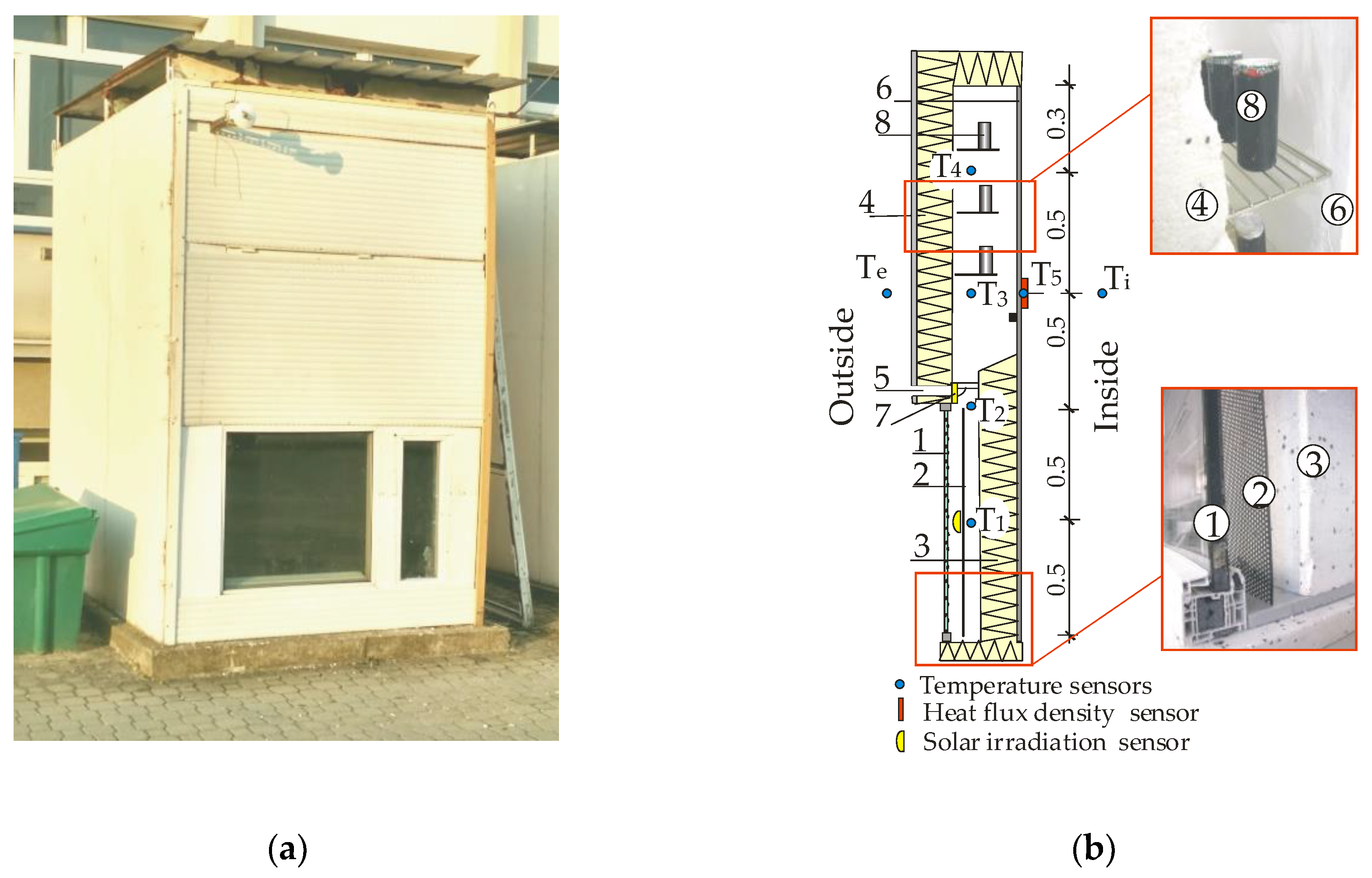
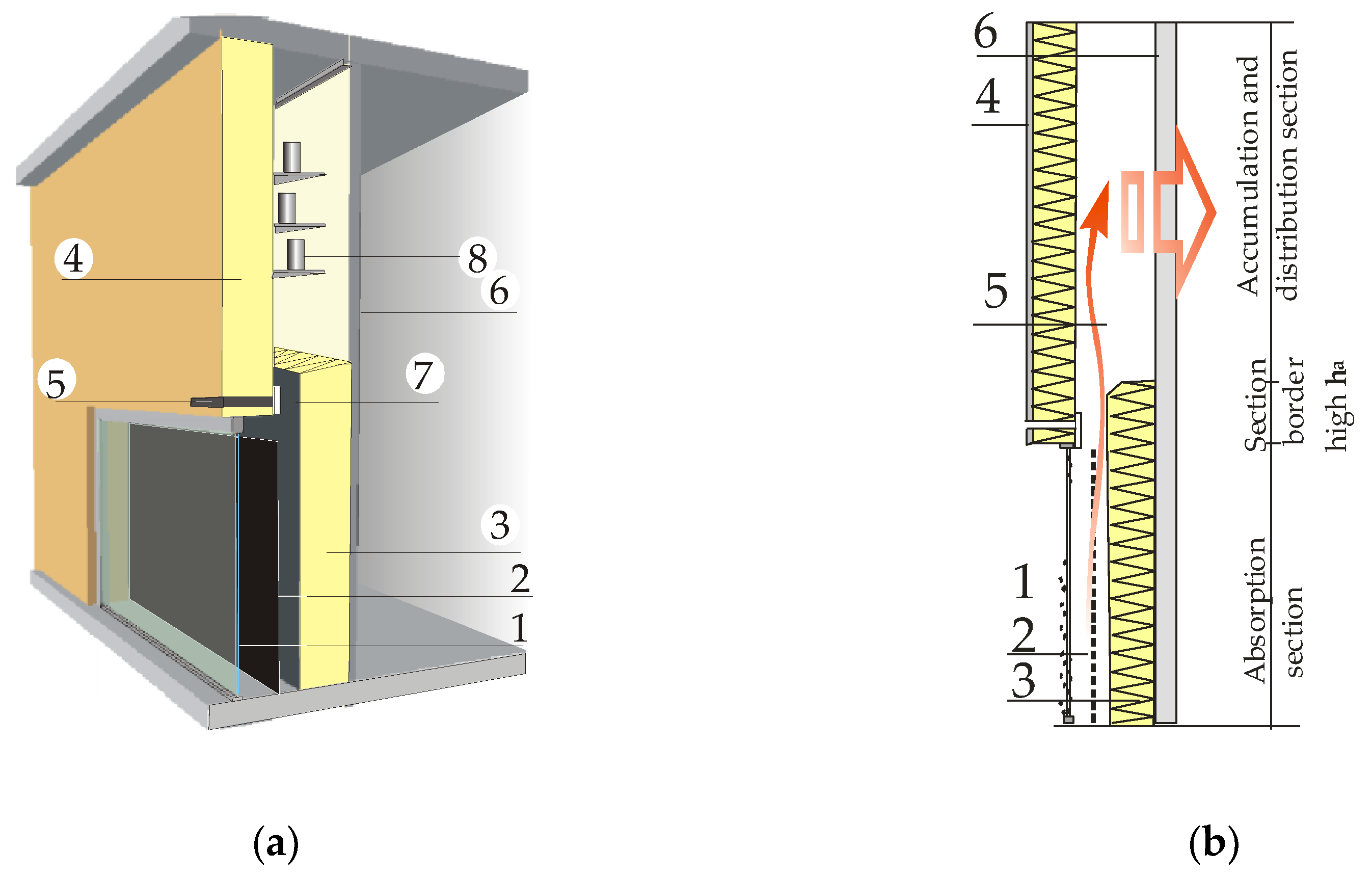
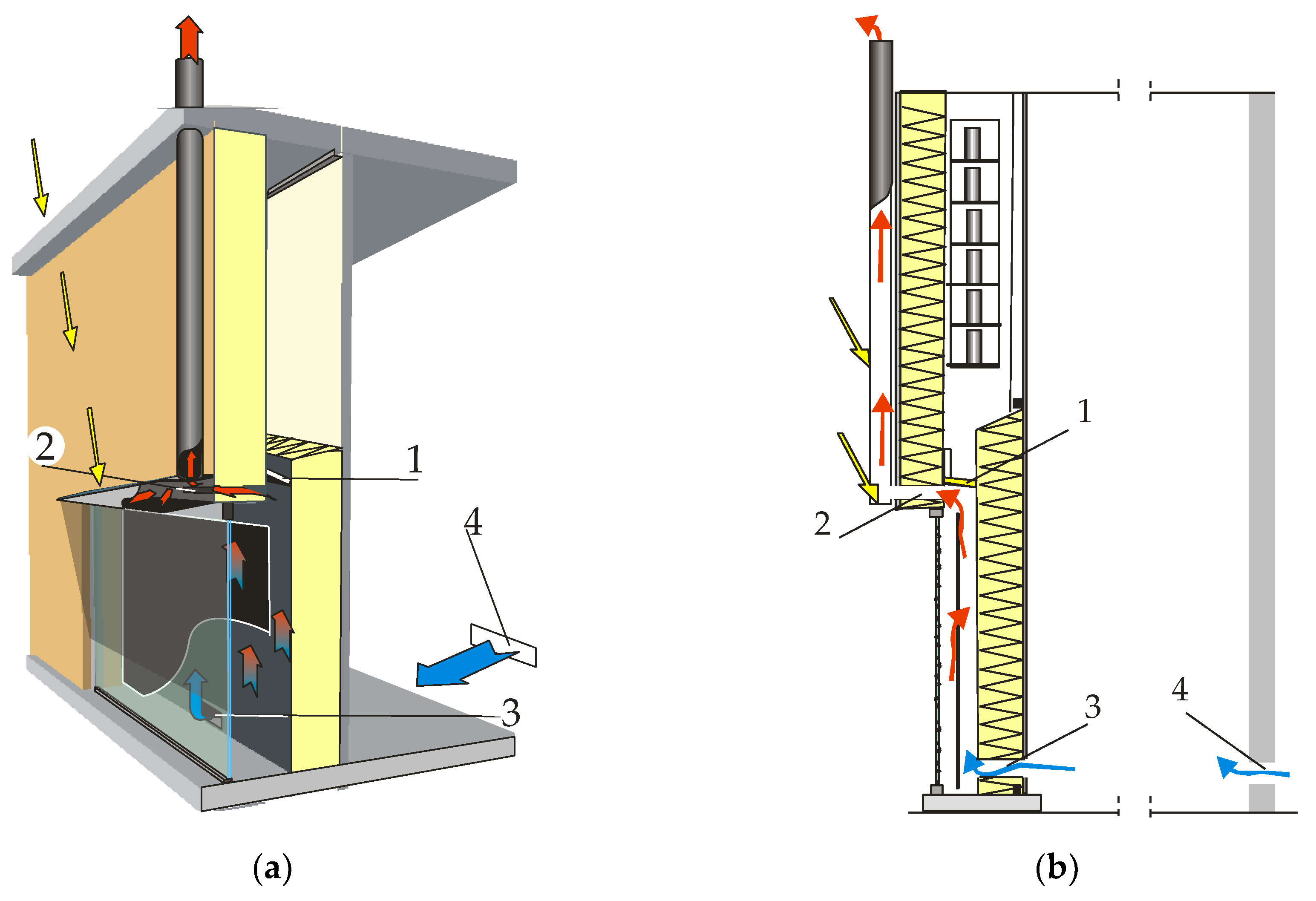


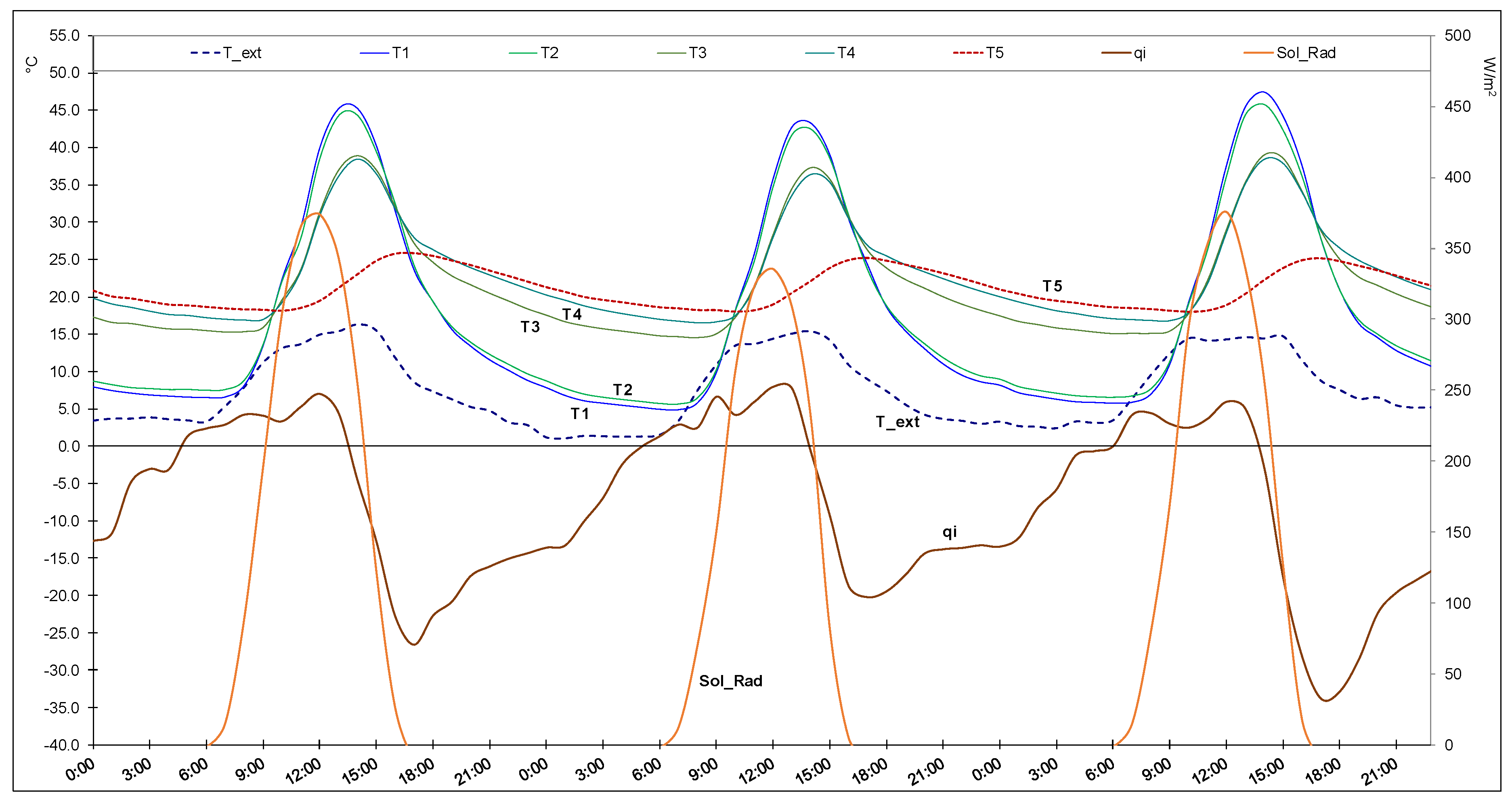

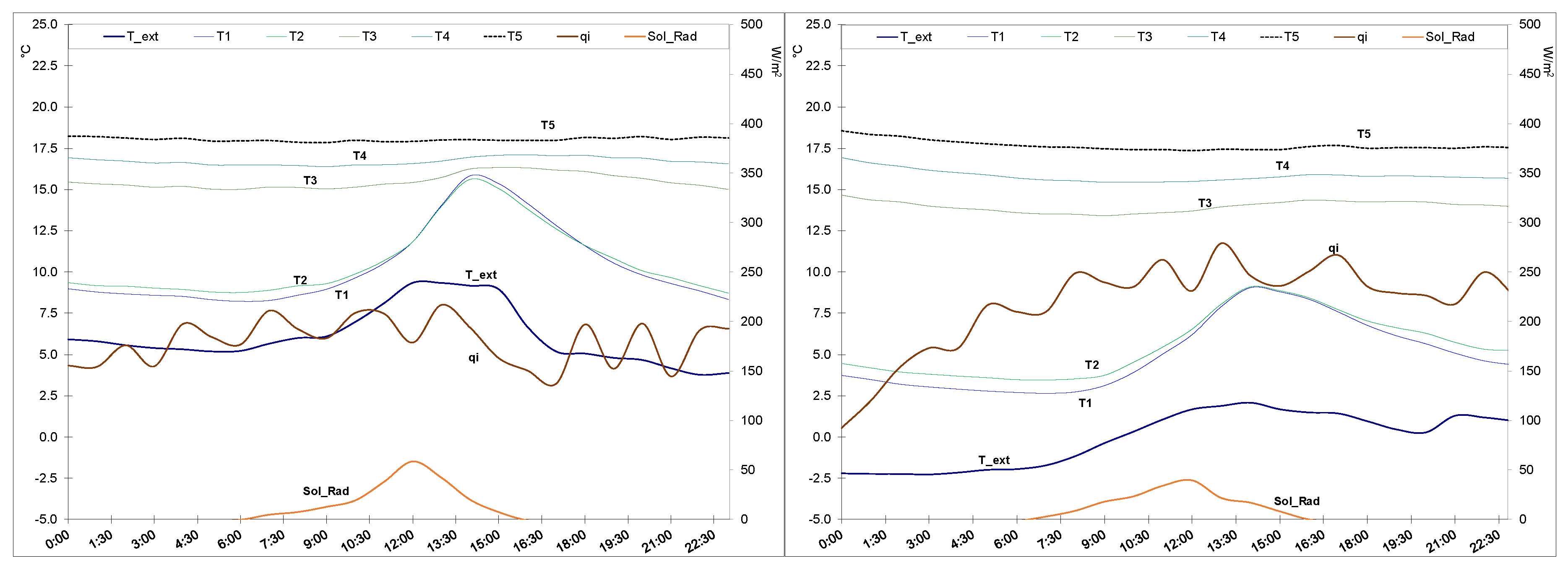
| Material | Function | Thermal Conductivity (W/m·K) | Density (kg/m3) | Specific Heat (J/kg·K) |
|---|---|---|---|---|
| Expanded polystyrene | Upper external insulation | 0.036 | 20 | 1460 |
| Plasterboard | Internal wall | 0.17 | 900 | 1000 |
| Expanded polystyrene | Lower internal insulation | 0.036 | 20 | 1460 |
| Stainless-steel sheet | Absorber | 25 | 7900 | 460 |
| Type | Glass Thermal Transmittance(W/m2·K) | Frame Thermal Transmittance(W/m2·K) | g Value | |
| Glazing | 4/16/4 | 1.2 | 0.9 | 0.68 |
| Measurement | Type | Accuracy |
|---|---|---|
| Temperature | ZA 9020-FS Thermo E4 | ±0.05 K, ±0.05% of the measured value |
| Heat flux density | ALMEMO FQ A020 C | <6% of the measured value |
| External air temperature | PT1000 | ±0.2 °C (−200 °C to +100 °C) |
| Solar irradiance | DeltaOhm LP Pyra12 | <1% (first class) |
| Date | Rad_sol (Wh/m2) | T_ext,ave (°C) | Thermal Loss (Wh/m2) | Efficiency (-) |
|---|---|---|---|---|
| 15 Feb | 360.6 | 5.2 | 178.5 | 0.0% |
| 16 Feb | 4316.6 | 6.3 | 129.9 | 8.7% |
| 17 Feb | 4639.4 | 7.9 | 36.0 | 12.0% |
| 18 Feb | 3962.2 | 6.9 | 42.3 | 12.8% |
| 19 Feb | 4621.4 | 8.0 | 31.5 | 15.3% |
| 20 Feb | 1266.2 | 6.3 | 46.3 | 9.4% |
| 21 Feb | 516.2 | 6.1 | 138.2 | 0.0% |
| 22 Feb | 4643.8 | −0.1 | 105.3 | 7.6% |
| 23 Feb | 3961.3 | −2.0 | 107.0 | 4.5% |
| 24 Feb | 448.1 | −0.1 | 193.8 | 0.4% |
| 25 Feb | 2896.7 | 5.5 | 148.2 | 5.8% |
| 26 Feb | 3163.0 | 7.2 | 69.1 | 7.4% |
| 27 Feb | 2315.1 | 6.0 | 58.3 | 5.9% |
| 28 Feb | 3722.4 | 10.4 | 51.8 | 7.4% |
| 1 Mar | 2499.2 | 4.0 | 49.8 | 9.7% |
© 2020 by the authors. Licensee MDPI, Basel, Switzerland. This article is an open access article distributed under the terms and conditions of the Creative Commons Attribution (CC BY) license (http://creativecommons.org/licenses/by/4.0/).
Share and Cite
Szyszka, J.; Bevilacqua, P.; Bruno, R. An Innovative Trombe Wall for Winter Use: The Thermo-Diode Trombe Wall. Energies 2020, 13, 2188. https://doi.org/10.3390/en13092188
Szyszka J, Bevilacqua P, Bruno R. An Innovative Trombe Wall for Winter Use: The Thermo-Diode Trombe Wall. Energies. 2020; 13(9):2188. https://doi.org/10.3390/en13092188
Chicago/Turabian StyleSzyszka, Jerzy, Piero Bevilacqua, and Roberto Bruno. 2020. "An Innovative Trombe Wall for Winter Use: The Thermo-Diode Trombe Wall" Energies 13, no. 9: 2188. https://doi.org/10.3390/en13092188
APA StyleSzyszka, J., Bevilacqua, P., & Bruno, R. (2020). An Innovative Trombe Wall for Winter Use: The Thermo-Diode Trombe Wall. Energies, 13(9), 2188. https://doi.org/10.3390/en13092188







